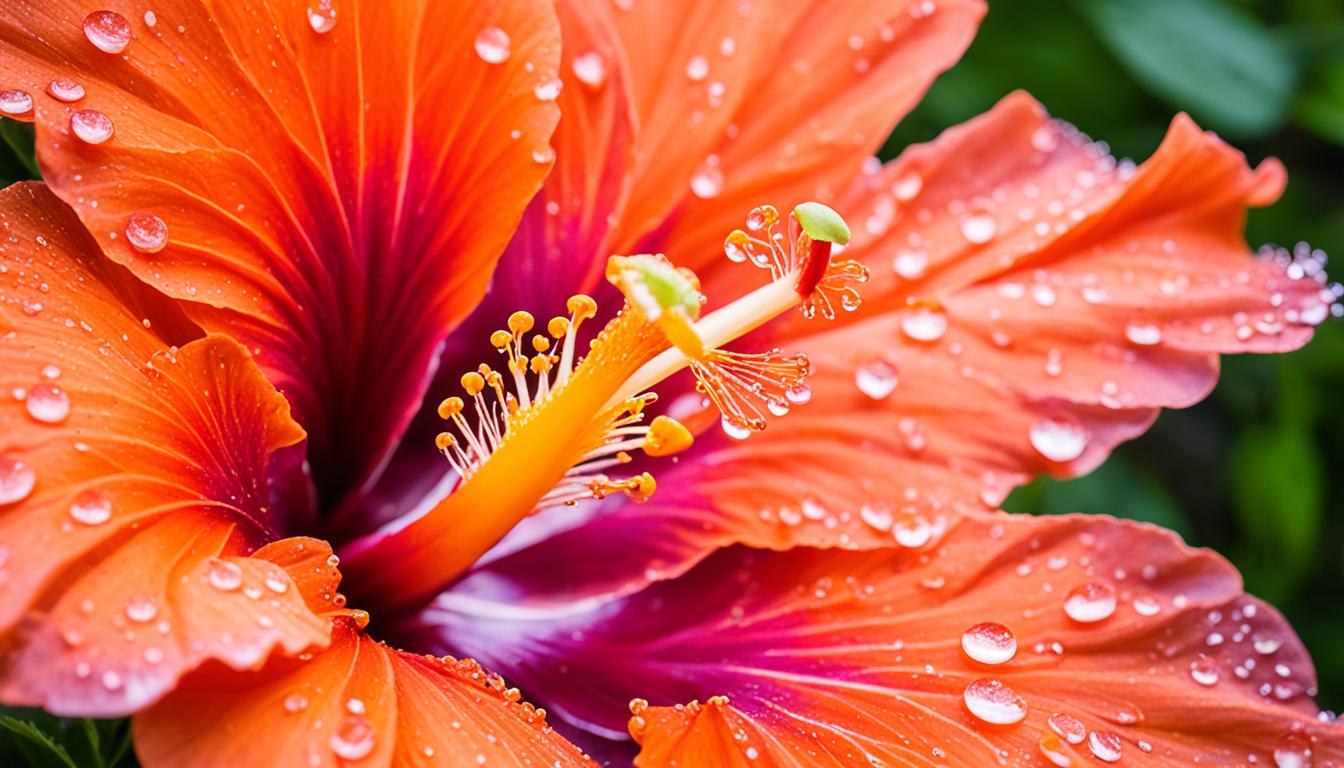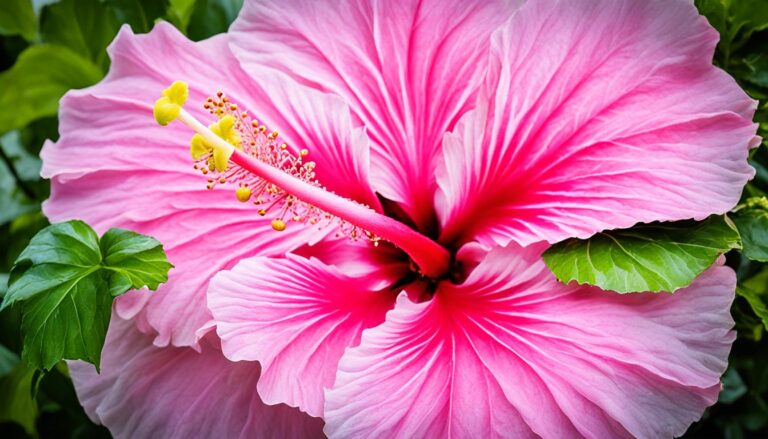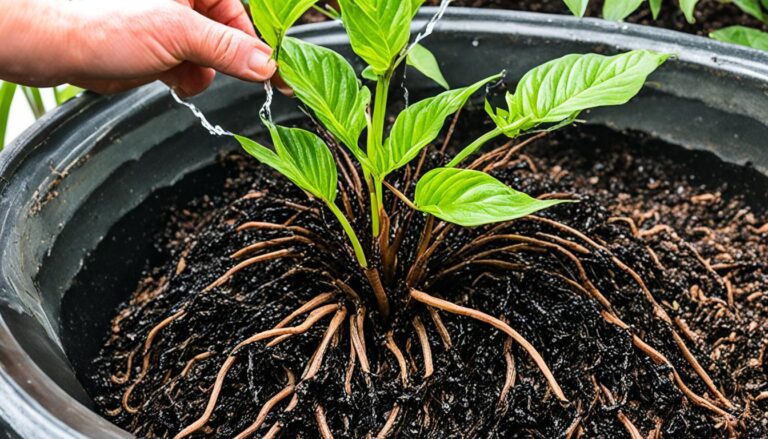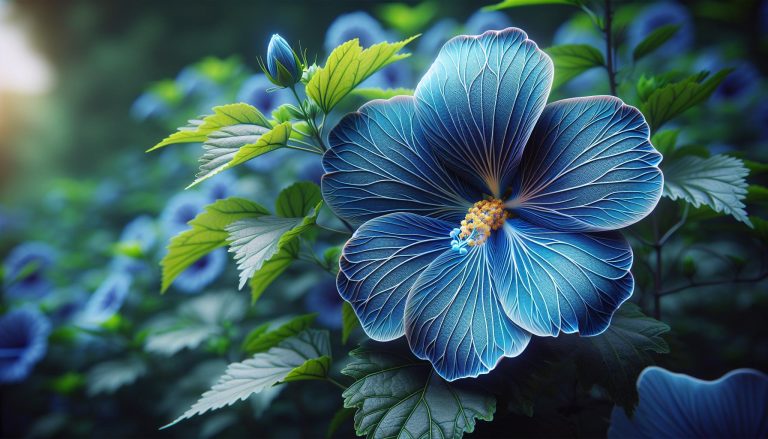Vibrant Orange Hibiscus Care Tips & Facts
Do you ever feel a sense of tranquility wash over you as you gaze upon a beautiful garden filled with blooming flowers? I know I do. There’s something about the vibrant colors, delicate petals, and sweet fragrance that captivate the senses and transport us to a place of serenity.
One flower in particular that never fails to capture my attention is the orange hibiscus. Its striking hue and tropical flair add a touch of exotic beauty to any outdoor space. Whether you’re an experienced gardener or just starting out, cultivating orange hibiscus plants can be a rewarding and fulfilling experience.
In this article, we’ll dive into everything you need to know about growing and caring for orange hibiscus. From gardening tips to plant care techniques, we’ll explore the secrets to nurturing these stunning flowers and creating breathtaking floral decorations.
Key Takeaways:
- Orange hibiscus adds vibrant color and tropical flair to your garden.
- Whether you’re a beginner or an experienced gardener, these care tips will help you nurture your orange hibiscus plants.
- Understanding the ideal growing conditions, fertilization techniques, pruning and maintenance, and container gardening will contribute to the healthy growth and vibrant blooms of your orange hibiscus.
- Knowing the common pests and diseases that can affect hibiscus plants will help you take preventive measures and maintain their health.
- Lastly, we’ll explore propagation techniques to multiply your orange hibiscus plants and answer some commonly asked questions about hibiscus care.
Types of Hibiscus: Tropical and Hardy
Hibiscus is a diverse genus of flowering plants that includes various species and hybrids. Two main types of hibiscus that are popular among gardeners are tropical hibiscus (Hibiscus rosa-sinensis) and hardy hibiscus (Hibiscus moscheutos).
Tropical Hibiscus
Tropical hibiscus is a medium-sized shrub known for its stunning, showy flowers. It is native to tropical and subtropical regions and thrives in warm climates. The vibrant blooms of tropical hibiscus come in various colors, including orange, red, pink, yellow, and white.
Tropical hibiscus is a popular choice for outdoor gardening and landscaping. It can be grown as a standalone plant, in flower beds, or even as a hedge or accent plant. In regions with mild winters, tropical hibiscus can be grown outdoors year-round. It is hardy in USDA plant hardiness zones 9-11.
Hardy Hibiscus
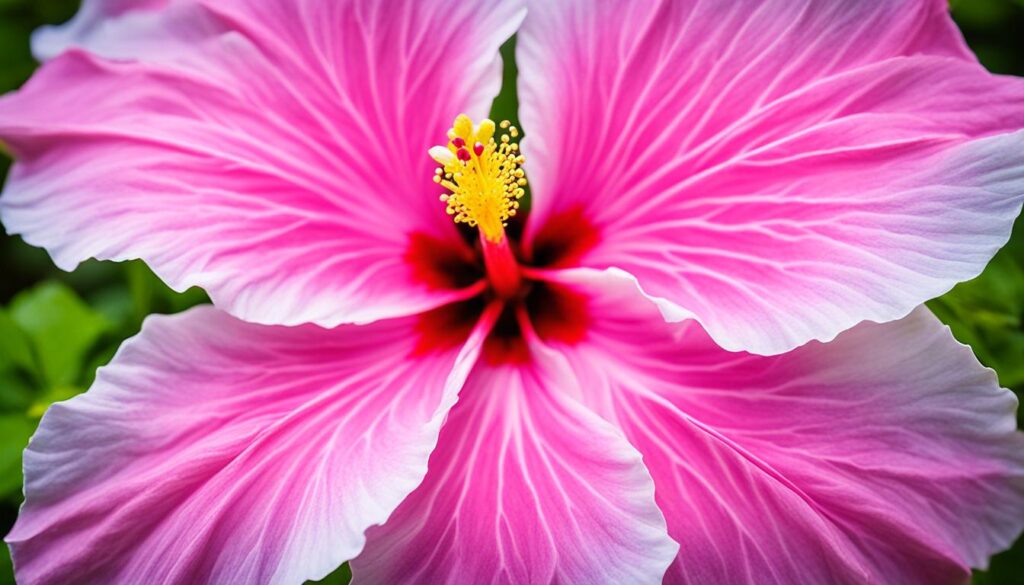
In contrast to tropical hibiscus, hardy hibiscus is a herbaceous perennial plant that dies back to the ground in winter and regrows in spring. It is also commonly known as rose mallow or swamp mallow. Hardy hibiscus is native to North America and can be found in wetlands and marshy areas.
Hardy hibiscus is beloved for its large, colorful flowers that resemble those of tropical hibiscus. The flowers of hardy hibiscus come in shades of red, pink, white, and combinations of these colors. The plant itself has a robust and upright growth habit, reaching heights of 3 to 8 feet.
Hardy hibiscus is well-suited for gardens in USDA plant hardiness zones 4-10. It can tolerate colder temperatures compared to tropical hibiscus, making it a great choice for gardeners in regions with freezing winters. With proper care and protection, hardy hibiscus can thrive and bring beauty to your garden year after year.
| Type of Hibiscus | Scientific Name | Characteristics | Hardiness Zones |
|---|---|---|---|
| Tropical Hibiscus | Hibiscus rosa-sinensis | Medium-sized shrub, showy flowers, tropical origins | Zones 9-11 |
| Hardy Hibiscus | Hibiscus moscheutos | Herbaceous perennial, large flowers, robust growth | Zones 4-10 |
Ideal Growing Conditions for Hibiscus
To ensure your orange hibiscus thrives, it’s important to provide it with the right growing conditions. Hibiscus prefer full sun to partial shade, depending on the type. They require moist, well-drained soil that is rich in organic matter. For tropical hibiscus, warm temperatures are essential, while hardy hibiscus can tolerate cooler climates. Proper spacing between plants allows for healthy growth, and regular watering is necessary to keep the soil consistently moist. Be aware of common pests like aphids and Japanese beetles, and take preventive measures to keep your plants healthy.
Sunlight
Hibiscus plants are sun lovers. They need at least 6 to 8 hours of direct sunlight to thrive. Place them in a location where they can receive ample sunlight throughout the day. However, if you live in a hot climate, providing partial shade during the hottest part of the day can help prevent sunburn on the leaves.
Soil
The right soil is crucial for the healthy growth of hibiscus plants. They prefer moist, well-drained soil that is rich in organic matter. A good mix of peat moss and perlite or sand can improve drainage. Adding organic compost to the soil can also provide the necessary nutrients for vibrant blooms.
Temperature
Hibiscus plants have different temperature preferences depending on the type. Tropical hibiscus thrives in warm temperatures between 65°F and 85°F (18°C to 29°C). Hardy hibiscus, on the other hand, can tolerate a wider range of temperatures, including cooler climates down to Zone 4. Ensure you understand the temperature requirements of your hibiscus variety to provide the ideal environment for growth.
Spacing
Proper spacing between hibiscus plants is essential for their healthy growth. Give each plant enough room to spread out and receive adequate sunlight and air circulation. The recommended spacing between hibiscus plants is between 3 to 6 feet (0.9 to 1.8 meters) depending on the variety. This allows each plant to grow to its full potential without overcrowding.
Water
Regular watering is necessary to keep the soil consistently moist for hibiscus plants. They require deep watering, ensuring the soil is soaked to a depth of 6 to 8 inches (15 to 20 cm) each time. Water the plants thoroughly, allowing the excess to drain out of the container or away from the root zone. Avoid overwatering, as it can lead to root rot and other water-related issues.
Pests
Common pests that can affect hibiscus plants include aphids and Japanese beetles. Regularly inspect your plants for signs of infestation, such as distorted leaves or sticky honeydew. Use preventive measures like spraying a solution of water and dish soap or using organic insecticides to control pests. Pruning damaged leaves and regularly cleaning the area around the plants can also help deter pests.
Fertilizing Your Orange Hibiscus
Hibiscus plants are heavy feeders and benefit from regular fertilization. Proper fertilization ensures that your orange hibiscus receives the necessary nutrients for healthy growth and vibrant blooms. Here are some fertilizing tips to help you keep your hibiscus thriving:
1. Slow-release fertilizer for continuous nourishment
A slow-release fertilizer is ideal for hibiscus plants as it provides a steady supply of nutrients over months. This allows your orange hibiscus to receive a consistent amount of nutrients for optimal growth and flowering. Apply slow-release fertilizer once a year, usually in spring, following the instructions on the product packaging.
2. Balanced fertilizer for regular nourishment
In addition to slow-release fertilizer, using a balanced fertilizer with a ratio like 10-10-10 every couple of months during the growing season can provide your orange hibiscus with the necessary nutrients. This balanced formula ensures that your hibiscus receives a mix of essential nutrients, promoting overall plant health and robust flowering.
3. Apply fertilizer evenly and avoid over-fertilization
When applying fertilizer, make sure to distribute it evenly around the root zone of your orange hibiscus. Avoid applying fertilizer directly to the stem or foliage, as this can cause damage. Over-fertilization can be detrimental to your hibiscus plant, as it can lead to excessive foliage growth at the expense of flowering. Follow the recommended dosage on the fertilizer packaging to prevent over-fertilizing.
4. Water thoroughly after fertilizing
After applying fertilizer, water your orange hibiscus thoroughly. This helps to ensure that the nutrients from the fertilizer are absorbed by the roots and made available to the plant. It also helps to prevent the accumulation of fertilizer salts, which can damage the roots and hinder nutrient absorption.
Incorporating these fertilizing tips into your hibiscus care routine will help you maintain healthy and vibrant orange hibiscus plants. Remember to follow the instructions on the fertilizer packaging and monitor your hibiscus for any signs of nutrient deficiencies or excesses. With the right fertilization regimen, your orange hibiscus will reward you with stunning blooms and lush foliage.
| Fertilizer Type | Application Frequency | Application Time |
|---|---|---|
| Slow-release fertilizer | Once a year | Spring |
| Balanced fertilizer | Every couple of months | During the growing season |

Pruning and Maintenance of Orange Hibiscus
Pruning is an essential aspect of maintaining the shape and size of your orange hibiscus plants. By removing dead or damaged branches hibiscus pruning, you can promote healthier growth and improve the overall appearance of your plants. Late winter or early spring is the ideal time to prune, as it allows the plants to recover and prepare for new growth timing.
Hardy hibiscus can be pruned close to the ground, as they have the ability to regrow pruning tips. This technique helps rejuvenate the plants and keeps them from becoming too woody. On the other hand, other types of hibiscus benefit from regular maintenance pruning to control their size and encourage lateral branching. This not only enhances the plant’s aesthetic appeal but also improves its overall health and vigor.
If you’re growing hibiscus in containers, it’s important to choose the right pot container care. Select a container that allows for proper drainage and has enough space for the root system to grow. This will prevent waterlogging and provide a healthy growing environment for your hibiscus. Additionally, consider using a high-quality potting mix that provides adequate nutrients and moisture retention.
Regular watering is crucial for the well-being of your hibiscus plants. Keep the soil consistently moist, but avoid overwatering as it can lead to root rot pot selection, watering. Check the soil moisture regularly and adjust your watering accordingly, especially during hot and dry periods. Remember, different hibiscus varieties may have varying water needs, so it’s essential to monitor their growth and adjust your watering schedule accordingly.
Like any other plants, hibiscus can be susceptible to pests and diseases pests and diseases. Common pests that may affect your orange hibiscus include aphids, mites, and whiteflies, while diseases like powdery mildew and leaf spot can also pose a threat. Regularly inspect your plants for any signs of pests or diseases, and take appropriate preventive measures, such as using organic insecticides or applying neem oil. Maintaining good overall plant health through proper care and maintenance can help minimize the risk of pest and disease infestations.
| Pruning Tips for Orange Hibiscus | Pot Selection and Care | Watering Recommendations | Pest and Disease Control |
|---|---|---|---|
| – Prune dead or damaged branches in late winter or early spring. | – Choose a pot with proper drainage and sufficient space for root growth. | – Keep the soil consistently moist, avoiding overwatering. | – Regularly inspect plants for pests and diseases, and take appropriate preventive measures. |
| – Hardy hibiscus can be pruned close to the ground for rejuvenation. | – Use a high-quality potting mix that provides nutrients and moisture retention. | – Adjust watering based on soil moisture and plant needs. | – Apply organic insecticides or neem oil to control common pests. |
| – Regular maintenance pruning helps control the size and promote lateral branching. | – Maintain good overall plant health to minimize the risk of pests and diseases. |
Growing Orange Hibiscus in Containers
Growing orange hibiscus in containers offers a convenient and versatile way to enjoy these vibrant flowers, whether you have limited outdoor space or prefer to cultivate them as houseplants. With proper care and consideration, you can create a stunning display of orange hibiscus in pots that will enhance any corner of your home or garden.
If you’re ready to embark on container gardening with orange hibiscus, here are some essential tips to ensure success:
Container Selection
Choose a large container with good drainage to prevent waterlogging and promote healthy root growth. Opt for a size that allows ample space for the hibiscus plant to expand, as larger pots provide better stability and moisture retention.
Potting Mix
Use a high-quality potting mix specifically formulated for container gardening. Look for a mix that provides adequate drainage while retaining moisture and nutrients. A well-draining potting mix promotes healthy root development and prevents waterlogged soil.
Watering
Container-grown hibiscus require regular watering to maintain consistent moisture levels. Keep the soil moist, but be careful not to overwater or allow the soil to become waterlogged. Check the soil’s moisture level by inserting your finger about an inch into the soil; if it feels dry, it’s time to water. Adjust your watering frequency based on the environmental conditions, such as temperature and humidity.
Sunlight
Place your container with orange hibiscus in a sunny location where it can receive at least 6 hours of direct sunlight each day. Hibiscus plants thrive in full sun, which contributes to their vibrant blooms and overall health. If growing indoors, choose a spot near a window that receives ample sunlight.
Repotting
Repot your orange hibiscus every couple of years to prevent root binding and promote healthy growth. Repotting allows the plant to access fresh soil and nutrients, providing it with the necessary resources for optimal development. When repotting, be careful not to damage the roots, and choose a pot that is slightly larger than the current one.
Temperature Considerations for Orange Hibiscus
The temperature requirements for orange hibiscus differ depending on the type. Tropical hibiscus varieties thrive in warm climates with temperatures above freezing, making them perfect for areas with year-round warmth. On the other hand, hardy hibiscus varieties can tolerate colder temperatures down to Zone 4.
For those living in warmer climates, orange tropical hibiscus can be enjoyed as outdoor plants all year long. These vibrant beauties will thrive in the warmth and sunshine, adding a tropical touch to your garden or landscape.
However, if you reside in a colder region, proper protection is essential to ensure the survival of tropical hibiscus during the winter months. You can opt to bring your tropical hibiscus indoors or provide winter protection using mulch and covers. By safeguarding your plants from the cold, you can ensure they stay healthy and ready to flourish when spring arrives.
Hardy hibiscus varieties, on the other hand, are more tolerant of cold climates. With their ability to withstand freezing temperatures down to Zone 4, they are a fantastic choice for gardens in regions with chilly winters. Hardy hibiscus will go dormant in winter and regrow in the spring, showcasing their stunning blooms year after year.
Winter Protection Tips for Tropical Hibiscus:
- Bring potted tropical hibiscus indoors before the first frost. Place them in a bright location with sufficient sunlight.
- If you have tropical hibiscus planted in the ground, apply a layer of mulch around the base of the plant to provide insulation against the cold.
- Consider using covers or blankets to protect your outdoor tropical hibiscus when temperatures drop below freezing.
By understanding the temperature preferences of your orange hibiscus plants, you can ensure their survival and optimal growth. Whether you live in a warm or cold climate, there is a hibiscus variety that will thrive in your garden. With proper care and protection, you can enjoy the vibrant beauty of orange hibiscus throughout the seasons.
Image:
Common Hibiscus Varieties and Their Characteristics
When it comes to hibiscus, there is no shortage of variety. Each hibiscus plant boasts its own unique characteristics, adding a touch of personal style to your garden. Whether you prefer tropical hibiscus favorites or hardy hibiscus favorites, there’s sure to be a variety that catches your eye.
Tropical Hibiscus Favorites
If you’re dreaming of bright, show-stopping blooms, tropical hibiscus varieties are the way to go. One popular choice is the Jazzy Jewel®. This stunning variety wows with large, vibrant flowers that will be sure to turn heads. Another tropical favorite is the Fiesta hibiscus. With its glossy foliage and crinkled orange flowers, Fiesta adds a touch of elegance and charm to any garden.
Hardy Hibiscus Favorites
For those looking for hibiscus varieties that are a bit more resilient to colder climates, hardy hibiscus favorites are an excellent choice. The Head Over Heels® series is a standout, displaying beautiful shades of white, pink, and red flowers against its rich burgundy foliage. With these hardy hibiscus varieties, you can enjoy a burst of color in your garden, even in cooler regions.
| Common Hibiscus Varieties | Characteristics |
|---|---|
| Jazzy Jewel® | Large, vibrant flowers |
| Fiesta | Glossy foliage, crinkled orange flowers |
| Head Over Heels® series | Shades of white, pink, and red flowers against burgundy foliage |
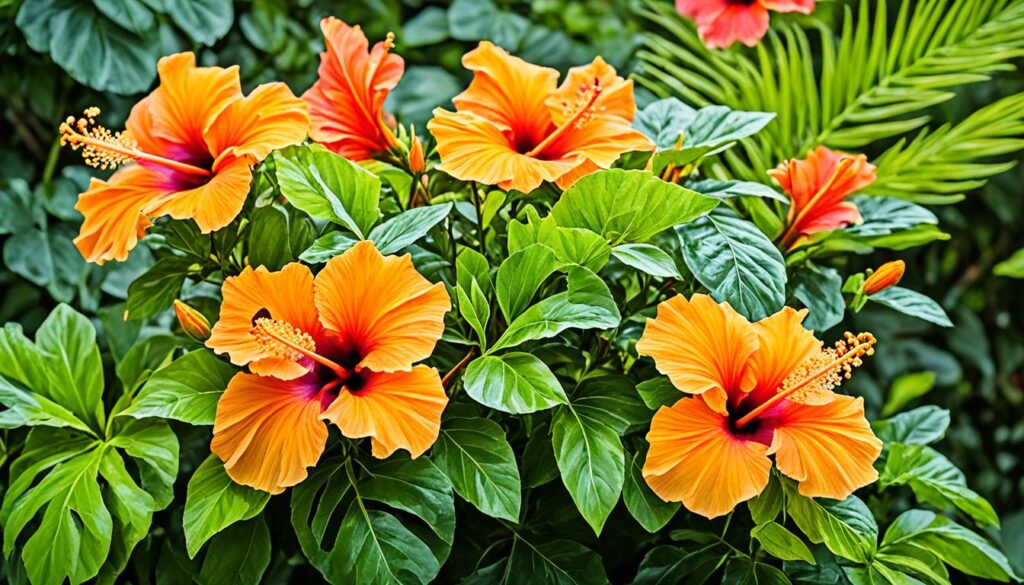
These are just a few examples of the many popular hibiscus varieties available. Whether you choose a tropical hibiscus favorite or a hardy hibiscus favorite, you’re sure to find a variety that suits your style and brings beauty to your garden.
Tips for Hibiscus Care: Sunlight, Soil, and Watering
Providing the right care for your orange hibiscus starts with understanding its sunlight, soil, and watering requirements. By following these hibiscus care tips, you can ensure that your plants thrive and reward you with vibrant blooms.
Sunlight Requirements
Hibiscus plants thrive in different levels of sunlight depending on the type. Tropical hibiscus prefers full sun, requiring at least 6 hours of direct sunlight daily to produce the most spectacular blooms. Hardy hibiscus, on the other hand, can tolerate light shade and can be grown in areas that receive partial sun. When selecting a location for your hibiscus, make sure it receives the appropriate amount of sunlight for optimal growth.
Soil Preferences
Hibiscus plants prefer moist, well-draining soil that is rich in organic matter. This ensures proper root growth and allows the plant to absorb essential nutrients. A good potting mix or garden soil mixed with compost is ideal for hibiscus. Avoid heavy clay soils that can retain excess moisture and lead to root rot. Regularly check the soil moisture and adjust watering accordingly to maintain the perfect balance for your hibiscus.
Watering Needs
Proper watering is crucial for hibiscus care. These plants require regular watering to keep the soil consistently moist, but avoid overwatering, which can lead to root rot. Water your hibiscus deeply, ensuring that the water reaches the root zone. A layer of organic mulch around the base of the plant helps retain moisture and regulate soil temperature. In hot weather, your hibiscus may require more frequent watering. Regularly monitoring the soil moisture and adjusting your watering routine accordingly will help keep your hibiscus healthy.
Remember to regularly check your hibiscus for signs of stress or dehydration, such as drooping leaves or wilted flowers. Adjust your watering schedule and provide additional moisture as needed.
Example Table: Ideal Sunlight, Soil, and Watering for Hibiscus
| Hibiscus Type | Sunlight Requirements | Soil Preferences | Watering Needs |
|---|---|---|---|
| Tropical Hibiscus | Full sun to partial shade | Moist, well-draining soil | Regular watering to keep soil consistently moist |
| Hardy Hibiscus | Light shade to full sun | Moist, well-draining soil | Regular watering to keep soil consistently moist |
Following these hibiscus care tips will help you provide the ideal environment for your orange hibiscus plants, ensuring they thrive and delight you with their vibrant blooms.
Common Pests and Diseases of Orange Hibiscus
While orange hibiscus plants are generally resilient, they can still fall victim to pests and diseases. Here are some of the most common issues to watch out for:
Pests:
- Aphids: These small insects can cluster on the undersides of leaves, sucking sap from the plant.
- Mealybugs: Mealybugs are white, cottony insects that feed on plant sap and excrete sticky honeydew.
- Caterpillars: Certain caterpillar species can chew on hibiscus leaves, causing damage.
- Japanese beetles: These beetles can skeletonize leaves and flowers, leaving hibiscus plants weakened.
To control these pests, regular inspections are necessary. Handpicking pests from the plant or using targeted insecticides can help eliminate them. Taking preventive measures, such as maintaining a clean garden and removing any infested plant debris, can also aid in pest control.
Diseases:
- Leaf spots: Various fungal or bacterial pathogens can cause leaf spots on hibiscus leaves, resulting in unsightly blemishes.
- Root rots: Overwatering or poorly draining soil can lead to root rot, which affects the health and vigor of hibiscus plants.
To prevent these diseases, proper care and maintenance are crucial. Avoid overwatering hibiscus plants and ensure they are grown in well-draining soil. Regularly inspecting plants for signs of disease and promptly addressing any issues can help keep your orange hibiscus healthy and thriving.
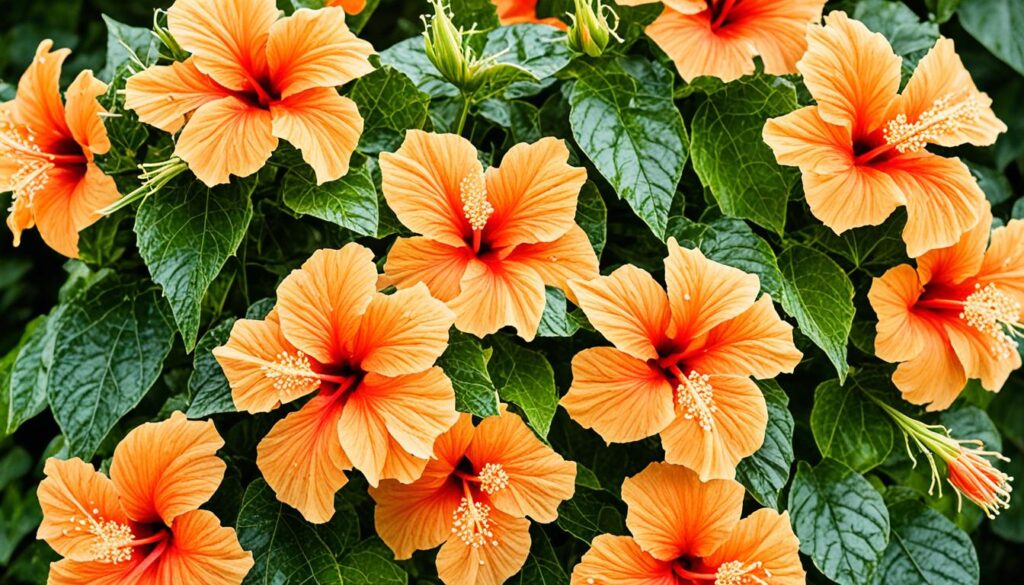
Pest and Disease Control in Orange Hibiscus
| Pest or Disease | Preventive Measures | Pest Control | Disease Management |
|---|---|---|---|
| Aphids | Regular inspections, remove infested parts of the plant, maintain garden cleanliness | Handpicking, use of insecticidal soap or horticultural oil | N/A |
| Mealybugs | Regular inspections, remove infested parts of the plant, maintain garden cleanliness | Wipe off with rubbing alcohol-soaked cotton swab, use of insecticidal soap or horticultural oil | N/A |
| Caterpillars | Regular inspections, handpicking, introduce natural predators | N/A | N/A |
| Japanese beetles | Regular inspections, remove beetles by hand, use beetle traps | N/A | N/A |
| Leaf spots | Avoid overhead watering, provide good air circulation | N/A | Remove affected leaves, apply fungicides if necessary |
| Root rots | Plant in well-draining soil, avoid overwatering | N/A | Improve drainage, prune affected roots, apply fungicides if necessary |
Hibiscus Propagation: Seeds and Cuttings
Propagating orange hibiscus can be done through seeds or stem cuttings. While seed propagation is more challenging and may not produce offspring true to the parent plant, it is recommended for certain hibiscus species like swamp hibiscus or roselle. Stem cuttings, on the other hand, are a common and successful method for propagating hibiscus. By following proper techniques and providing the right conditions, you can multiply your orange hibiscus plants and expand your garden.
Seed Propagation
If you decide to propagate your orange hibiscus from seeds, it’s essential to understand that the resulting plants may not have the same characteristics as the parent plant. However, seed propagation can be an exciting experiment, especially if you want to explore different varieties of hibiscus. Here’s how you can do it:
- Collect ripe hibiscus seeds from the parent plant.
- Remove any pulp or coating from the seeds by rinsing them under water.
- Prepare a seed tray or pots filled with seed starting mix.
- Plant the seeds about 1/4 inch deep in the soil.
- Place the tray or pots in a warm, well-lit location.
- Keep the soil consistently moist, but not waterlogged.
- After germination, thin out the seedlings and transplant them into individual pots when they have developed their first true leaves.
- Continue to care for the seedlings with proper watering and fertilization until they are ready to be planted in the garden.
Stem Cutting Propagation
Stem cuttings are a reliable method for propagating orange hibiscus and ensuring that the new plants retain the characteristics of the parent plant. Follow these steps for successful stem cutting propagation:
- Choose a healthy, non-flowering stem from the parent plant.
- Using clean and sharp pruning shears, make a clean cut just below a leaf node.
- Remove any leaves from the lower half of the cutting.
- Dip the cut end of the stem into rooting hormone powder to promote root growth.
- Prepare a pot or container with a well-draining potting mix.
- Make a hole in the soil and insert the cutting, gently pressing the soil around it to ensure stability.
- Water the cutting thoroughly and place it in a warm, bright location with indirect sunlight.
- Keep the soil consistently moist but not waterlogged.
- Monitor the cutting for signs of new growth, which indicates successful rooting.
- Once the cutting has established roots and started growing, you can transplant it into a larger pot or directly into the garden.
With these propagation techniques, you can multiply your orange hibiscus plants and enjoy their vibrant blooms throughout your garden or landscape. Whether you choose to grow them from seeds or stem cuttings, patience and proper care will reward you with beautiful new plants.
| Propagation Method | Advantages | Disadvantages |
|---|---|---|
| Seed Propagation |
|
|
| Stem Cutting Propagation |
|
|
Commonly Asked Questions About Orange Hibiscus
– Are hibiscus easy to grow?
Yes, hibiscus plants are relatively easy to grow, making them a popular choice among gardeners of all skill levels. With proper care and attention to their specific needs, you can enjoy the beauty of vibrant orange hibiscus blooms in your own garden.
– How fast do hibiscus grow?
Hibiscus plants are known for their fast growth rate. Depending on the variety and environmental conditions, orange hibiscus can grow several inches to a foot or more in a single growing season.
– What are the common problems with hibiscus?
Common problems that hibiscus plants may encounter include pest infestations, such as aphids and spider mites, as well as diseases like fungal leaf spot. Providing the right care, including regular inspections, proper watering, and preventive measures, can help mitigate these issues.
– Are hibiscus poisonous to dogs?
Yes, some parts of the hibiscus plant, including the flowers and leaves, can be toxic to dogs if ingested in large quantities. It is best to keep pets away from these plants or consult with a veterinarian if you suspect your dog has consumed hibiscus.
– How long do hibiscus flowers last?
The duration of hibiscus flowers depends on various factors, including the specific variety and environmental conditions. Generally, each individual flower will last for a day or two before wilting. However, hibiscus plants produce continuous blooms throughout the growing season, ensuring a visually stunning display.
– How can I keep my hibiscus blooming?
To encourage continuous blooming in your orange hibiscus plants, provide them with the optimal growing conditions. This includes ample sunlight, regular watering, appropriate fertilization, and proper pruning. Deadheading spent flowers and removing any damaged or diseased parts can also promote new growth and blooming.
– Is hibiscus a perennial or annual?
Orange hibiscus can be either a perennial or an annual, depending on the specific variety and the climate in which it is grown. Tropical hibiscus varieties are typically perennial in warm climates, while hardy hibiscus varieties can be perennial in colder regions.
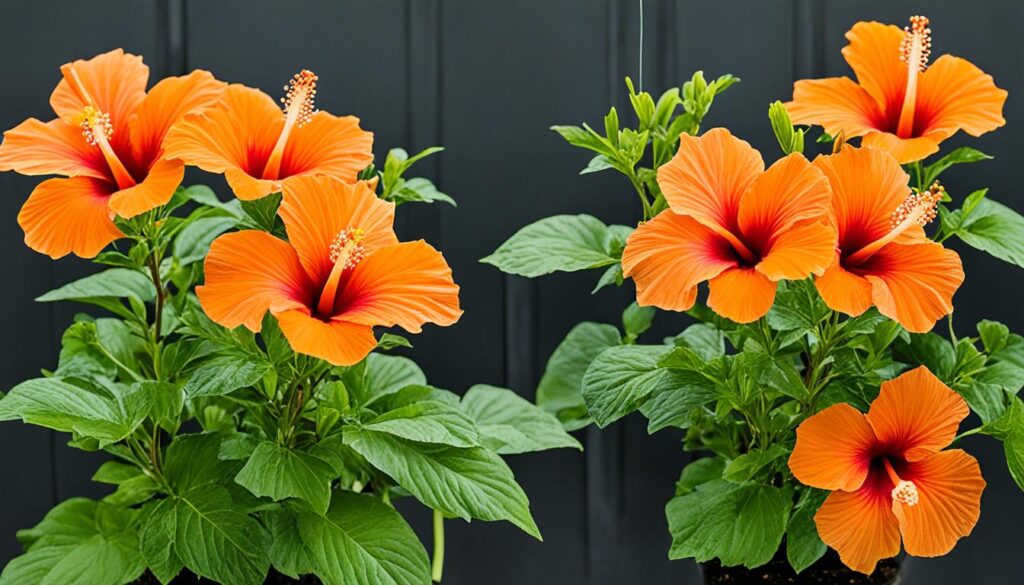
| Question | Answer |
|---|---|
| Are hibiscus easy to grow? | Yes, hibiscus plants are relatively easy to grow, making them a popular choice among gardeners of all skill levels. |
| How fast do hibiscus grow? | Hibiscus plants are known for their fast growth rate. Depending on the variety and environmental conditions, orange hibiscus can grow several inches to a foot or more in a single growing season. |
| What are the common problems with hibiscus? | Common problems that hibiscus plants may encounter include pest infestations, such as aphids and spider mites, as well as diseases like fungal leaf spot. Providing the right care, including regular inspections, proper watering, and preventive measures, can help mitigate these issues. |
| Are hibiscus poisonous to dogs? | Yes, some parts of the hibiscus plant, including the flowers and leaves, can be toxic to dogs if ingested in large quantities. It is best to keep pets away from these plants or consult with a veterinarian if you suspect your dog has consumed hibiscus. |
| How long do hibiscus flowers last? | The duration of hibiscus flowers depends on various factors, including the specific variety and environmental conditions. Generally, each individual flower will last for a day or two before wilting. However, hibiscus plants produce continuous blooms throughout the growing season, ensuring a visually stunning display. |
| How can I keep my hibiscus blooming? | To encourage continuous blooming in your orange hibiscus plants, provide them with the optimal growing conditions. This includes ample sunlight, regular watering, appropriate fertilization, and proper pruning. Deadheading spent flowers and removing any damaged or diseased parts can also promote new growth and blooming. |
| Is hibiscus a perennial or annual? | Orange hibiscus can be either a perennial or an annual, depending on the specific variety and the climate in which it is grown. Tropical hibiscus varieties are typically perennial in warm climates, while hardy hibiscus varieties can be perennial in colder regions. |
Conclusion
In conclusion, orange hibiscus is a beautiful and vibrant addition to any garden or landscape. These tropical flowers bring a touch of exotic charm with their stunning blooms. By following the care tips outlined in this article, you can ensure the healthy growth and abundant blooms of your hibiscus plants.
Key takeaways from this article include selecting the right hibiscus varieties for your climate, providing optimal growing conditions such as sunlight and well-drained soil, and regularly maintaining and pruning your plants. It’s also important to be mindful of common pests and diseases that can affect your orange hibiscus, taking preventive measures and addressing any issues promptly.
Whether you are a seasoned gardener or a beginner, growing orange hibiscus can be a rewarding experience. These vibrant flowers can transform your outdoor landscaping or brighten up your indoor floral decorations. So, unleash your creativity and create a stunning tropical oasis with your orange hibiscus. Happy gardening!

